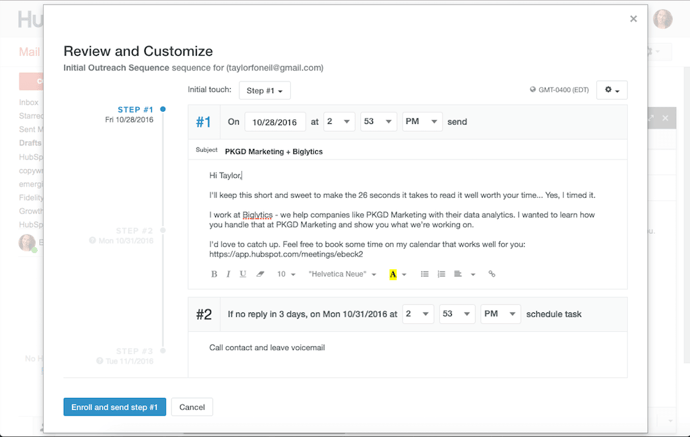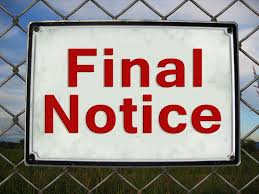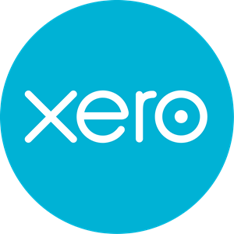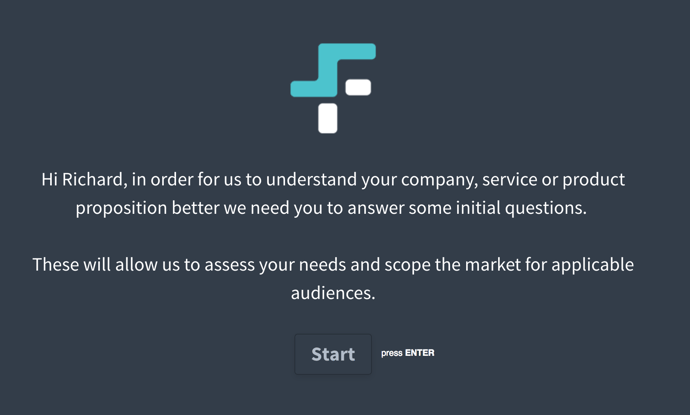


Making time: 8 things you can automate in your sales process




I love sales automation. It sets my inner tech geek alight. It's sad, but I spent much of my Friday evening last week playing around with our own Six & Flow automation. I like doing it, it's a big puzzle, kind of like putting together the old Mousetrap board game. If put together perfectly, it's a
Done right, sales automation has the potential to make everyone's life easier. Even better, it has the potential to give back time (or free up more time in the future, if you're being pedantic). Even better still, it has the potential to help our prospects (and customers) too.
Sales enablement is a strategic, cross-functional discipline designed to increase sales results and productivity. It provides integrated content, training and coaching services for salespeople along the entire customer's buying journey. If you want to find out how it can transform your business, read our blog: 'Will sales and marketing harmony be the death of the sales qualified lead?'
We work with a number of
Think about it, how many chasing emails do you send after you've fired out a brochure, quote or proposal? Do you check back in after three days, a week, a month?
One of the fastest areas for growth across our business and within our service offerings is 'sales enablement'. For us, that means helping you and your sales team grease the sales wheels, removing friction and repetition where possible and ultimately adding value to the end results (or sales). We help clients to position marketing material within their sales process. Effectively, we combine sale and marketing into a coherent and collaborative process, and for the most part, we help them automate it.
Obviously, there's an awful lot you wouldn't want to
Here are 8 things we think you should feature
The chase
Getting clients to the point where they are willing to have the in-depth calls where you can figure them out, excite them about the potential of working together AND line them up for the next steps...
1. Automate your initial outreach and follow ups
According to HubSpot, 80% of sales require 5
Whether it's a lack of time or outright laziness (I'm poking fun here), there's room for improvement. One of the easiest things to do

Sales enablement nudges go both ways. Your prospect needs to know you're there and you the seller needs to be given the odd reminder that there's a hot prospect (and possibly some commission) on the other end too.
What tools do we use? Mostly, HubSpot
2. Knowledge is power
The more you know about your prospect, the easier it is for you to figure out how you could possibly help them. Knowing their name, good start, knowing their contact details, essential. Knowing their estimated turnover, their Linkedin biography, Klout score etc etc etc... That's just excellent prep. Selling digital services? It would be good to know if you're talking to the next Larry Kim, Matt Cutts or Rand Fishkin, right?

We're a HubSpot partner, so as you can expect, a lot of the sales enablement tools in our armoury are clad in HubSpot orange. When it comes to company information like turnover and industry, the HubSpot CRM already has you covered. It's a great tool, but you can do more - the next little gem we use for automating the research piece in the sales process is FullContact.
Get a free consultation on how to automate your sales process >>
For those of you not familiar with FullContact, it basically allows you to take an email address and run it through its "Person API", spitting out all sorts of information
We then use a combination of Zapier and HubSpot to pull it all into the contacts CRM entry. It's in real time, so by the time I've had a new lead notification as a sales guy, all this data is already in there, ready for me. It
3. Qualify the buy
One of the most
We score leads. As soon as you visit our site (like now for example), we're assessing you. We're building up a picture. How many of our blogs have your read? How many guides or worksheets did you download? Did you use that awesome little Growth Driven Design calculator? Are you visiting our contact pages? Does your phone number work? Did your email bounce? These are a small number of the things we're looking at. The best bit? It's all in

When a lead crosses that threshold, we set off all manner of alarms and signals across the company. HubSpot rotates the assignment of the lead across our sales team. That sales person gets a notification via email, Slack and sometimes SMS (depending on the campaign) and they jump on in to see where they can help.
The reasoning behind this? It means our small sales team spends
The tools we use here? HubSpot Marketing (Pro) with
4. Meeting links
Without a doubt, meeting links are my current favourite sales tool. I hate, with a passion, having to go back and forth trying to organise a meeting between my over-stacked calendar and that of busy clients. We both have to look hard to to find gaps in our diaries, and the three or four emails it takes to find them just clutter up our inboxes.
The meetings tool, again part of HubSpot Sales Pro, allows you to seamlessly integrate your calendar with


The follow-up
So, you've managed to get your lead on the phone. You had a good initial call and now you're moving them through your funnel. How much nudging, pushing and reminding do you normally do here? If it's anything like us, loads.
With each step of the process, there's a sequence of events that needs to complete for a prospect to become a client. In part, managing prospective clients can be like herding cats. Meeting reminders, information and documentation requests, follow up calls. It can be endless, and all the while treading a fine line between being assertive and pushy.
It can be time-consuming and there's a lot of room for sales to go astray. Missed opportunities
5. Reminders for you, reminders for me
Once you send a lead a document, a brochure for example, there's some obvious things you want to know as a sales person. Did they read it? Do they want it? The first of those two questions is easy to answer. We can track email opens, brochure downloads (or views) and any manner of metrics that tickle your fancy. If they've not read it or opened it,
The aim of the sales enablement game here is to reduce chasing and follow up, again.
So how can we tell if they 'want it' - there's a couple of core things we can look at. The first is to look at which pages they read and how long for. Lingering on existing client reviews or even your pricing page? They're probably considering a purchase.

Then we can start to look at other metrics. Have they shared it with other members of their team? How many times have they read it? These are all good indicators that a purchase is being considered.
And, a pro tip... make sure you have an really good "break up" email as part of your reminder automation. Something along the lines of "I'm guessing you're no longer looking to grow your revenues this year. Please feel free to get in touch when that changes."
Depending on what we're sending, the tools we use here are normally HubSpot Sales Pro and Workflows in HubSpot Marketing Pro.
Get a free consultation on how to automate your sales process >>
6. Client homework
This is, without a doubt, the one thing we won't move forward without. Client homework is about two things; The first is finding out more information so that we can have real conversations about the company. The second, and probably the more important aspect, is it shows engagement and willingness from you, a prospective client. Prospects that fill in homework normally become clients.
We automate three things here; sending the client homework (which is an email with a link), capturing the information (we use attractive and efficient Typeform, similar to our GDD calculator) and then, assuming we've not heard back from you, we'll use automation to keep nudging you. We appreciate that when you're buying a service, you might not expect to do homework, but that's just the way we roll.
For this step, we use a combination of templates within HubSpot Sales Pro, automation in HubSpot Marketing Pro workflows and Typeform.
7. Proposal automation
This is a bit of a con. We can't automate proposals in their entirety, but we can make them an awful lot easier by automating the processes around them.
Think about your normal proposal process. You create a proposal. You create a potential deal in your CRM. You send your proposal. You book a follow up call with your proposal. You chase the proposal sign off... There's a lot that can be taken off of your plate there.
 We use Proposify for our proposals. It allows us to template the repetitive bits and leaves us more time to focus on working out the actual solution. It also allows us to link seamlessly with HubSpot workflows, the HubSpot CRM (which is free by the way...) and our accounts system, Xero.
We use Proposify for our proposals. It allows us to template the repetitive bits and leaves us more time to focus on working out the actual solution. It also allows us to link seamlessly with HubSpot workflows, the HubSpot CRM (which is free by the way...) and our accounts system, Xero.
As soon as a proposal is sent, it becomes a potential deal in the CRM. Once it's signed off, they become a client in the CRM, created as a client in Xero and an invoice is created... It's like magic, and it removes some of that onboarding overhead.
I won't go into too much detail on this, as a lot of the processes are very similar to the reminders above, but what I will say (I guess it's another 'pro tip') use the break up email if you start to find clients are "ghosting" you.
The admin
I hate admin. There's not enough excitement or variability in it for me. It's not something I relish doing and it's often the thing that gets left to the last minute. So, we automate admin, not just because we can, but because it frees up time to do the things we're good at AND ensures that things get done when they are supposed to, as they are supposed to. In short, sales enablement can help with all the boring bits.
8. Contract automation
Contracts are fiddly, and it's important to get them right. God forbid you have to pull one of them up for use at some point, you want to make sure it's done properly.
Our contracts are all very similar. We change the outlines of services, delivery dates, fees associated etc. But the core to it is always the same.
To help with our contracts, we use PandaDocs. It links natively with the HubSpot CRM to pull through information and prepopulate the contract where possible.

Well, that's it for this blog, but it's the very beginning of what you can with sales automation. We've not even touched on webinars, training videos and referrals! We would love to speak to you about how sales enablement could help your business - just get in touch if you'd like to chat.
Sales enablement is a strategic, cross-functional discipline designed to increase sales results and productivity. It provides integrated content, training and coaching services for salespeople along the entire customer's buying journey. If you want to find out how it can transform your business, read our blog: 'Will sales and marketing harmony be the death of the sales qualified lead?'









